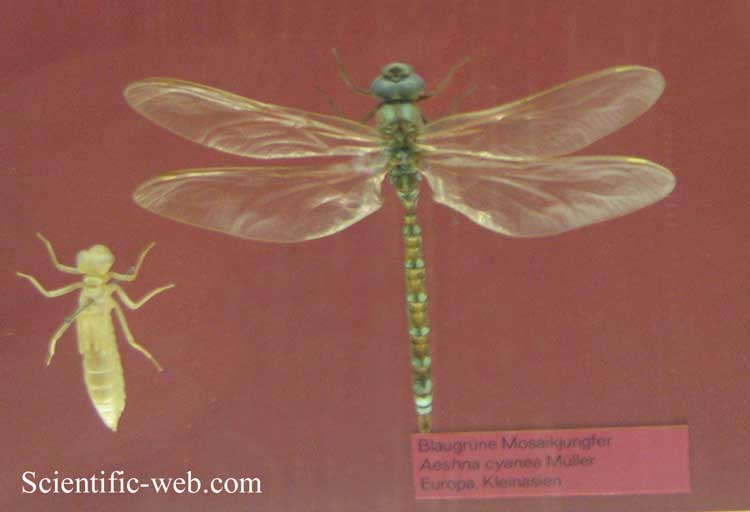
Aeshna cyanea , Southern Hawker
Superregnum: Eukaryota
Regnum: Animalia
Subregnum: Eumetazoa
Cladus: Bilateria
Cladus: Nephrozoa
Cladus: Protostomia
Cladus: Ecdysozoa
Cladus: Panarthropoda
Phylum: Arthropoda
Subphylum: Hexapoda
Classis: Insecta
Cladus: Dicondylia
Subclassis: Pterygota
Cladus: Metapterygota
Cladus: Odonatoptera
Cladus: Holodonata
Ordo: Odonata
Subordo: Epiprocta
Infraordo: Anisoptera
Superfamilia: Aeshnoidea
Familia: Aeshnidae
Subfamilia: Aeshninae
Tribus: Aeshnini
Genus: Aeshna
Species: Aeshna cyanea
Name
Aeshna cyanea O. F. Müller, 1764
Vernacular names
Deutsch: Blaugrüne Mosaikjungfer
English: Southern Hawker
suomi: Kirjoukonkorento
français: Æschne bleue
magyar: Sebes acsa
Plattdüütsch: Blau Glasemaker
Nederlands: Blauwe Glazenmaker
norsk: Blågrønn øyenstikker
polski: żagnica sina
українська: Коромисло синє
中文: 藍晏蜓
The southern hawker or blue hawker (Aeshna cyanea) is a species of hawker dragonfly.[2][3]
Distribution
The species is one of the most common and most widespread dragonflies in Europe. The total range is West Palearctic and covers a large part of Europe (to Scotland and southern Scandinavia in the North to Italy (without the Southwest) and the northern Balkans to the South); the Eastern boundary is formed by the Ural and the West by Ireland. It is also found in Northwest Africa (Algeria). In Central Europe the species is very common.[4]
Habitat
These dragonflies mainly inhabit well-vegetated, small ponds and garden ponds, but they wander widely, and they are often seen in gardens and open woodland.[5]
Description
Close-up of head and thorax of a male
Aeshna cyanea can reach a body length of about 70 millimetres (2.8 in),[5] with a wingspan up to 110 millimetres (4.3 in).[6] It is a large, brightly coloured dragonfly, with a long body. The thorax is brown, with two ante-humeral wide green longitudinal stripes. On the forehead there is a black spot in the form of the letter T. The wings are hyaline with a dark pterostigma. The leading edge of the wings is dark.
Males have a dark abdomen with bright apple green markings, except for the last segments S8-10 of the abdomen, where the markings are pale blue and joined. In the females, the abdomen is brownish with bright green markings.[5] The eyes of the males are blue or greenish-blue, while in the females they are yellowish green or brownish.
Biology and behavior
Flight period of these insects lasts from June to October, with some specimen visible in May and November.[5] The adults of the southern hawker feed on various insects, caught on the wing. This is an inquisitive species and will approach people.[5]
These dragonflies breed in still or slow-flowing water. The males are often seen patrolling by a ponds edge or river, where they fight away intruders, crashing into rival males and spiralling through the air. The females are quite inconspicuous when they lay their eggs, but they sometimes give away their spot by clattering up from the reeds.
The eggs are laid by jabbing the abdomen into rotting vegetation or wood. The eggs hatch in the spring, after being laid in the previous summer or autumn. The nymphs feed on aquatic insects, small tadpoles, invertebrates and small fish. They emerge as adults in July and August after two-three years’ development.
Moulting phase of Aeshna cyanea
Life cycle
Mating
Female ovipositing
Larva
Female freshly emerged with larva skin
Exuvia
Immature male
Immature female
mature male, blue form
In flight
Mature Female
See also
List of British dragonflies
Schorr, M. and Paulson, D. 2015. World Odonata List. Tacoma, Washington, USA .
References
Boudot, J.-P. (2018). "Aeshna cyanea". IUCN Red List of Threatened Species. 2018: e.T165524A83891998. doi:10.2305/IUCN.UK.2018-1.RLTS.T165524A83891998.en. Retrieved 19 November 2021.
BioLib
Bisby F.A., Roskov Y.R., Orrell T.M., Nicolson D., Paglinawan L.E., Bailly N., Kirk P.M., Bourgoin T., Baillargeon G., Ouvrard D. Catalogue of life
Fauna europaea
British Dragonflies
Richard Robinson Askew, The Dragonflies of Europe, Harley Books, 2004, p. 109.
Retrieved from "http://en.wikipedia.org/"
All text is available under the terms of the GNU Free Documentation License

